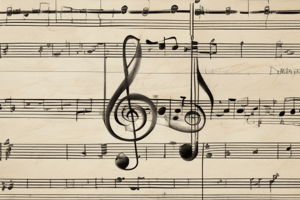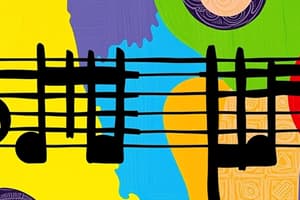Podcast
Questions and Answers
What defines the perceived frequency of sound?
What defines the perceived frequency of sound?
- Timbre
- Pitch (correct)
- Dynamics
- Rhythm
Which term describes the pattern of sound in time, including elements like beat and tempo?
Which term describes the pattern of sound in time, including elements like beat and tempo?
- Timbre
- Dynamics
- Rhythm (correct)
- Pitch
Which of the following describes the quality or color of sound that distinguishes different instruments?
Which of the following describes the quality or color of sound that distinguishes different instruments?
- Pitch
- Dynamics
- Timbre (correct)
- Rhythm
What is a musical phrase primarily considered to be?
What is a musical phrase primarily considered to be?
What type of intervals are defined by their distance between two pitches, such as C to G?
What type of intervals are defined by their distance between two pitches, such as C to G?
Which type of scale includes all twelve pitches within an octave?
Which type of scale includes all twelve pitches within an octave?
Which of the following best describes 'stepwise' movement in melody?
Which of the following best describes 'stepwise' movement in melody?
How does harmony function in conjunction with a melody?
How does harmony function in conjunction with a melody?
Flashcards are hidden until you start studying
Study Notes
Music Theory
-
Definition: The study of the practices and possibilities of music.
-
Basic Elements:
- Sound: Vibration produced by an object.
- Pitch: Perceived frequency of a sound (high vs. low).
- Rhythm: Pattern of sound in time; includes beat, tempo, and meter.
- Dynamics: Volume of sound (loudness or softness).
- Timbre: Quality or color of sound that distinguishes different voices or instruments.
-
Notation:
- Staff: Five lines and four spaces that represent different pitches.
- Clefs: Symbols at the beginning of the staff indicating pitch range (e.g., treble and bass clefs).
- Notes and Rests: Symbols representing sound (notes) and silence (rests).
-
Scales:
- Chromatic Scale: Includes all twelve pitches within an octave.
- Diatonic Scale: Seven-note scale (e.g., C major, A minor) that forms the basis of Western music.
-
Intervals: Distance between two pitches. Common types include:
- Major: (e.g. C to E)
- Minor: (e.g. C to Eb)
- Perfect: (e.g. C to G)
-
Chords:
- Triads: Three-note chords formed by stacking thirds (e.g., major, minor).
- Seventh Chords: Four-note chords that include the root, third, fifth, and seventh.
Melody
-
Definition: A sequence of musical notes that are perceived as a single entity; the main theme of a piece of music.
-
Characteristics:
- Contour: The shape of the melody as it moves up and down in pitch.
- Range: The span between the lowest and highest pitches.
- Emotion: Melodies often convey particular feelings or moods.
-
Types:
- Stepwise: Moves in small intervals (steps) from one note to the next.
- Leaps: Involves intervals larger than a whole step, creating contrast.
-
Phrasing:
- Musical Phrase: A complete musical thought, often resembling a sentence.
- Cadence: The resting place at the end of a phrase; can be perfect (conclusive) or imperfect (less conclusive).
-
Repetition and Variation:
- Repetition: Reinforces a melody, making it memorable.
- Variation: Alters the melody in some way (e.g., changing rhythm or pitch) while maintaining its core identity.
-
Harmony and Melody: Melodies are often supported by harmonies, which enhance the emotional effect and fullness of the sound.
Music Theory
- The study of how music works and its possibilities
- The basic elements of music are sound, pitch, rhythm, dynamics, timbre, and notation
Sound
- The vibration produced by an object
Pitch
- The perceived frequency of a sound, determining if it's high or low
- Represented on a staff with five lines and four spaces
Rhythm
- How sound unfolds over time
- Involves beat, tempo, and meter
Dynamics
- The volume of sound, ranging from loud to soft
Timbre
- The unique color or quality of a sound, differentiating instruments and voices
Notation
- A system of symbols used to represent music
- Staff: Five lines and four spaces representing pitches
- Clefs: Indicate pitch ranges (treble and bass clefs)
- Notes: Symbols representing sounds
- Rests: Symbols representing silence
Scales
- Organized sets of notes
- Chromatic Scale: Includes all 12 pitches within an octave
- Diatonic Scale: Contains 7 notes, forming the basis of many Western music pieces
- Major and Minor Scales: Common types of diatonic scales
Intervals
- The distance between two pitches
- Major, Minor, Perfect: common interval types
Chords
- Combinations of notes played simultaneously
- Triads: Composed of three notes stacked in thirds
- Seventh Chords: Composed of four notes, based on the root, third, fifth, and seventh
Melody
- A sequence of notes perceived as a single entity
- The main theme of a piece of music
Melody Characteristics
- Contour: The shape of the melody, determined by its upward and downward movements
- Range: The distance between the lowest and highest notes
- Emotion: Melodies often express specific feelings or moods
Types of Melodic Movements
- Stepwise: Consists of small intervals, moving from one note to the next smoothly
- Leaps: Involves larger intervals that create contrast
Melody Phrasing
- Musical Phrase: A complete musical thought, similar to a sentence
Cadence
- The resting place at the end of a musical phrase
- Perfect cadence: Gives a conclusive feel
- Imperfect cadence: Less conclusive, creating a sense of continuation
Repetition and Variation
- Repetition reinforces a melody for memorability and focus
- Variation alters the melody, changing rhythm, pitch, or other elements while preserving its core identity
Harmony and Melody
- Harmony supports melody, enhancing the emotional impact of the music and creating a fuller sound
Studying That Suits You
Use AI to generate personalized quizzes and flashcards to suit your learning preferences.




